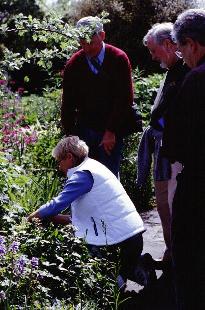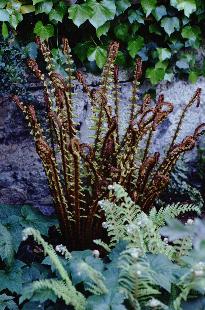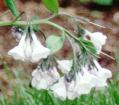 Helen Dillon, a world renouned garden writer shown here with members of our
tour, maintains her
private, walled garden located in the city of Dublin, Ireland. I suppose that
the rare blue Himalayan poppies (Meconopsis sp.) growing along the walkway
at the entry of her home should have been an indicator of the excellence
we were about to enjoy.
The rare blue poppies are among the most difficult plants to grow, yet her plants were so robust we joked
that she probably has to grub them out like weeds lest they take over the garden.
Helen Dillon, a world renouned garden writer shown here with members of our
tour, maintains her
private, walled garden located in the city of Dublin, Ireland. I suppose that
the rare blue Himalayan poppies (Meconopsis sp.) growing along the walkway
at the entry of her home should have been an indicator of the excellence
we were about to enjoy.
The rare blue poppies are among the most difficult plants to grow, yet her plants were so robust we joked
that she probably has to grub them out like weeds lest they take over the garden.
Graciously greeted at the front door by Helen and her husband, Val, we were escorted through
the living room to the pristine garden in the back yard. Here we viewed
horticultural perfection.
The large, rectangular lawn is flanked on both sides with perennial borders,
carefully color coordinated, and accented with a shallow, circular reflecting
pool at the end. The borders are not solid, but are laced with garden paths
that connect to small garden rooms, each containing plants of the rarest order
and all expertly grown. The general garden vista is clearly formal, but the
stroll through the plantings is like an informal walk through a rare plant
collection.
Because of the relatively sweet soil in Dublin, there were no rhododendrons
in the Dillon garden, but their collection of wildflowers was phenomenal. Huge
clumps of rare trillium varieties amazed me, especially a double white form
of Trillium grandiflorum. Several years ago, I had admired a single flower of
the double Trillium during a Rhododendron Soceity Convention tour in Portland,
Oregon. Here we were greeted by a clump with several dozen flowers, all in
perfect condition. There were clumps of red trillium, yellow trillium, and
a dwarf white form, too, all carefully placed among companion plants of the
very highest order.
 The yellow and white tree peonies were at peak condition, but with the Dillon
garden there was a feeling that every day, some other rare plant would be
in bloom. Clearly, this was a garden that changes its moods and views as
the season progresses, but I couldn't imagine being there at a more perfect
time. Anxious to capture some of this beauty with my camera's new macro lens,
I kept twisting my body into strange contortions, trying to frame that
perfect picture. Leaning over packed flower beds, and carefully navigating
stepping stone paths, I was able to get most of my shots. But as we were
about to leave, I longed to capture this fern against the stone wall as its
fronds were expanding. I studied the situation, and then very carefully
positioned my foot on a rare, unplanted spot of earth in the flower bed,
leaned over and snapped my picture. At that point, Helen Dillon
noticed my intrusion and asked me to please refrain from walking in the
flower beds. Embarrassed, I apologized and felt extremely guilty, knowing
the potential damage I could have done if I had stepped on some choice
gem, or worse yet, fallen down in the bed. She must have recognized me to
be a clutz of the highest order, one oblivious to the perils of the
surrounding world. Actually, I would not
fall down in any gardens for several more days. I saved my big show
for the ponds at Hestercombe.
The yellow and white tree peonies were at peak condition, but with the Dillon
garden there was a feeling that every day, some other rare plant would be
in bloom. Clearly, this was a garden that changes its moods and views as
the season progresses, but I couldn't imagine being there at a more perfect
time. Anxious to capture some of this beauty with my camera's new macro lens,
I kept twisting my body into strange contortions, trying to frame that
perfect picture. Leaning over packed flower beds, and carefully navigating
stepping stone paths, I was able to get most of my shots. But as we were
about to leave, I longed to capture this fern against the stone wall as its
fronds were expanding. I studied the situation, and then very carefully
positioned my foot on a rare, unplanted spot of earth in the flower bed,
leaned over and snapped my picture. At that point, Helen Dillon
noticed my intrusion and asked me to please refrain from walking in the
flower beds. Embarrassed, I apologized and felt extremely guilty, knowing
the potential damage I could have done if I had stepped on some choice
gem, or worse yet, fallen down in the bed. She must have recognized me to
be a clutz of the highest order, one oblivious to the perils of the
surrounding world. Actually, I would not
fall down in any gardens for several more days. I saved my big show
for the ponds at Hestercombe.
 The Dillons were extremely gracious, serving us tea and autographing copies
Helen's excellent and witty books on gardening. The image at the top of
this page is actually Helen digging a few bulbs of
a rare pale pink oxalis for our leader, George McLellan, in the red sweater.
George wants to
introduce this delicate form in the United States. As we discussed other rare
plants we grew, I wondered how I could send Helen a piece of something I
had that she didn't,
a white form of Virginia Bluebells, Mertensia virginica alba.
"All serious gardeners are smugglers", she smiled. Perhaps if she visits in the
Washington D.C. one day, I can give her a piece from my white Bluebell plant
pictured here.
If not, I'll try to stay at home next spring and collect seed.
Guardians of rare plants are obligated to propagate and distribute
them, anyway.
The Dillons were extremely gracious, serving us tea and autographing copies
Helen's excellent and witty books on gardening. The image at the top of
this page is actually Helen digging a few bulbs of
a rare pale pink oxalis for our leader, George McLellan, in the red sweater.
George wants to
introduce this delicate form in the United States. As we discussed other rare
plants we grew, I wondered how I could send Helen a piece of something I
had that she didn't,
a white form of Virginia Bluebells, Mertensia virginica alba.
"All serious gardeners are smugglers", she smiled. Perhaps if she visits in the
Washington D.C. one day, I can give her a piece from my white Bluebell plant
pictured here.
If not, I'll try to stay at home next spring and collect seed.
Guardians of rare plants are obligated to propagate and distribute
them, anyway.
|